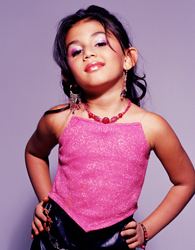“Smile for the camera!”
 It’s Halloween and you are together with friends having the time of your life, but the only thing you can think of is how to pose for the picture. “What side is my good side? I’m self conscious of my arms so I’ll put it on my hip, knee slightly bent, turn sideways…Okay the angle is right. Take the picture.”
It’s Halloween and you are together with friends having the time of your life, but the only thing you can think of is how to pose for the picture. “What side is my good side? I’m self conscious of my arms so I’ll put it on my hip, knee slightly bent, turn sideways…Okay the angle is right. Take the picture.”
In a film regarding social identity, Sut JHally, a Professor at the University of Massachusetts, forms the calculated inferences that the sexualization of women is formed first in the media. He discusses that the poses in magazine advertisements mean more than just an attempt to get the reader to buy a product.
Flipping through magazines it is apparent that there is immense focus that goes into taking a single picture, much like the pictures women take with their friends on a daily basis. Women are seen with their knee slightly bent, and the hip to the side. Jhally suggests that this is in an attempt to make women seem off-balance, as if their world could spin out of control at any moment. Men are often seen standing straight with their arms folded to portray masculinity in a way that shows they can take on the world as it comes and are afraid of nothing.
As I was watching the film the thought crossed my mind, I do this all the time. (See Above Picture). It seems natural to take a picture with a tilted posture, but where did I learn this from? These habits are not something we pick up at birth, it is a learned habit which stems from advertisers trying to make an impression on young women.
The way women are portrayed in ads is as though they are being controlled by the environment around them. They are often seen cradling things, delicate and lightly. They caress the object as though they might drop it at any moment. This is known as the feminine touch.
This is known as the feminine touch.
In the media, women are often shown as desirable, something to be obtained and therefore women’s hands are less likely to be holding something in a firm manner, but more likely to trace an object or cradle it.
In this image for example, the woman is barely holding her bottle of water, she touches it with only her finger tips rather than maintaining a full grasp of it. This image also shows the media’s inability to separate women from their childlike selves.
Women are often seen in a fetal position or showing childlike tendencies, also known as infantilization. Jhally suggests that while men are seen to transition from boys to adults through labor and hard masculine work such as chopping wood or building something with their hands, women are portrayed the same way whether they are adults or children.
The resulting factor is that children are growing up too quickly because they want to look and act like the older models.  This is making little girls grow up more quickly than they should causing experimentation with makeup, clothing and ultimately boys.
This is making little girls grow up more quickly than they should causing experimentation with makeup, clothing and ultimately boys.
In advertisements such as this one, little girls are shown holding the same pose a woman twice her age would. With her hands on her hips and her head cocked in a seductive way, there is no separation between the child and the adult. There is the lack of separation between childhood and adulthood and as a furthering result the media is now mixing childhood with sexuality. They don’t look like real people but rather dolls that can do anything you want.  The consequence is that young girls are equated with grown women. They pose in the same sexualized way a grown woman would leaving no room to distinguish between the innocence of childhood and the perceived sexuality of adulthood.
The consequence is that young girls are equated with grown women. They pose in the same sexualized way a grown woman would leaving no room to distinguish between the innocence of childhood and the perceived sexuality of adulthood.
The way women are perceived in the media is ridiculous and so it was addressed in one youtube video, what would happen if there was some role reversal?
Jhally discusses this concept in the film as well, men are seen as so masculine that showing them on their knees or with far-off expressions is crazy. The codes of masculinity are always defined in relation to women through binary opposition. If a woman is weak and emotional, a man is strong and shows emotional control along with self assurance and poise. Therefore, showing a man in an advertisement playing the role of a woman seems strange to the viewer.
The main problem with the media is that they try to present the world in a way that could be real. This entices the viewer to buy the product, or watch the commercial rather than change the channel. What we as viewers don’t realize is the effect it is having on us in something as simple as a photograph. There is nothing natural about the gender attributes in the media and how society constructs and labels us as how we should act.
Next time you pick up a magazine, look through the images, what do you see? Do you see women as sexual icons caressing objects or replicating the poses of innocent children? Perhaps you see no difference between children and adults because they are presented in a way that allows for no differentiation between the two. The message from the media is clear, age does not matter…sexualization does.